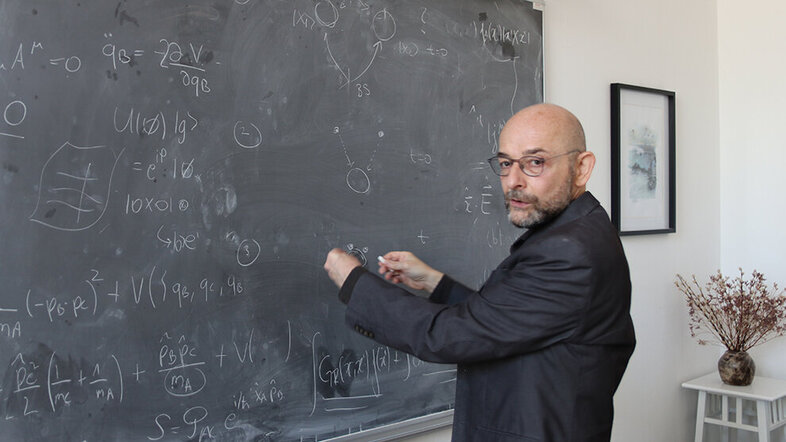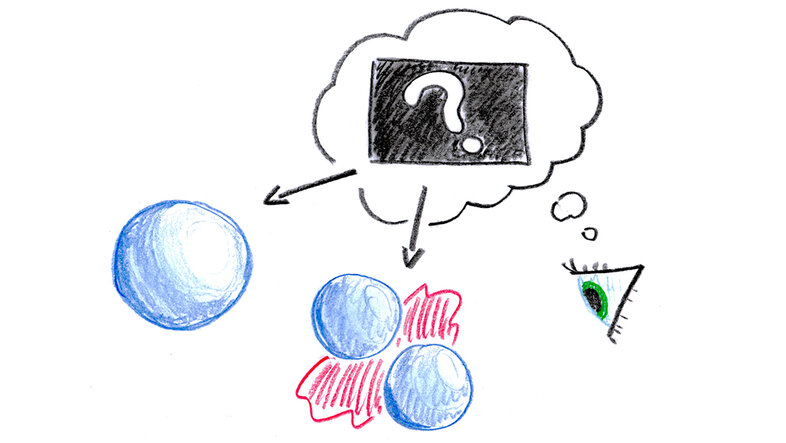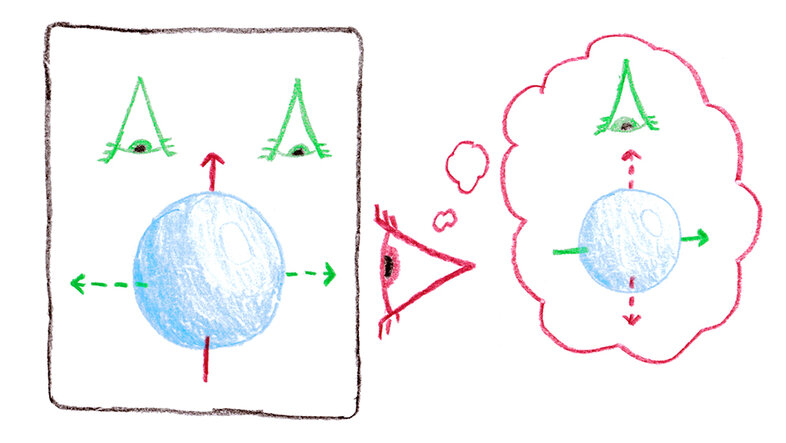When there is no reality without observation
"This is exactly where Erwin Schrödinger's office used to be. His desk remained here for a long time, but eventually, we had to move it because we didn’t want it damaged during coffee breaks." With these words, quantum physicist Časlav Brukner begins our conversation at Boltzmanngasse 5 in the 9th district of Vienna, where the Faculty of Physics is located.
Schrödinger—or at least his cat—will, of course, come up in our discussion, but we will spend most of our time talking about the so-called 'things' that are "not there if you do not observe them." It will be a conversation which first denies the existence of an objective reality independent of observation and then questions what observation and reality are in the first place.
World Quantum Day on 14 April 2025
Each year, World Quantum Day celebrates and promotes public awareness and understanding of quantum science and technology around the world. This year, the University of Vienna will organise a German event "ASK A SCIENTIST - Von Schrödinger's Katze zum Quantencomputer", featuring Anne-Catherine de la Hamette (University of Vienna) and Martin Ringbauer (University of Innsbruck). They will answer questions concerning fundamental concepts of quantum physics, such as superposition, interference, and entanglement, and explain how quantum technologies are changing the world. #WorldQuantumDay
Reality is fundamentally probabilistic
"Historically, physics has aimed to describe the world as it 'truly' is—independent of our observations or an observer. But quantum physics seems to challenge, or even shatter, that ambition," states the professor of quantum foundations and quantum information theory. In quantum physics, he explains, it is fundamentally impossible to assume that the properties of objects exist prior to measurement—but even when we perform a measurement, we cannot be certain which property will be observed.
"The decay of atoms, for example, can only be described in the language of quantum physics, which uses the language of probabilities—in other words, we are always and only talking about possibilities when we try to explain what we’re seeing," explains Brukner.
What is the difference between probabilistic and deterministic descriptions?
Classical physics describes the world in a deterministic way—which means that we can predict outcomes by thinking about how events would certainly unfold under ideal conditions. Probabilistic descriptions, on the other hand, are only able to say how probable a given measured result is. Classical physics also works with probabilistic descriptions, "but these are merely an expression of the fact that we do not know the true circumstances," says Časlav Brukner. In other words, probabilities in classical physics merely reflect our ignorance. "Yet this is not the case in quantum physics, where probabilities occur in a fundamental, non-reducible way—there is no deterministic cause behind them." This means that the world, at its core, is indeterminate.
Any attempt to find "the hidden factors" behind these probabilities contradicts some fundamental principles, Brukner adds: "Whenever we assume that there are mechanistic causes behind the probabilities, this leads to theorems that are then disproved by experiments. That suggests to me that our idea of reality, as we know it from everyday life and classical physics, should be loosened." Reality itself, it seems, is fundamentally probabilistic.
How not to understand Schrödinger's cat
There is thus a very bizarre relationship between observation and the observed. Before we bring up Schrödinger's cat, we should first clear up a widespread misunderstanding of this famous thought experiment.
It is not true that before being measured, the cat—or the atoms—is at the same time both dead (or decayed) and alive (or intact). In many science texts aimed at the general public, one often reads that a light particle can be in two places at the same time. Brukner prefers a more nuanced take on things: "In my opinion, that is an imprecise formulation that I've always tried to avoid." It is better to say that the concrete state is 'neither' one or the other or that it's simply 'undefined'—it does not exist. This "state of non-existence" is referred to by quantum physicists as "superposition."
© University of Vienna/Corporate Communications
"I have never observed something that has been in two places at the same time."Časlav Brukner
Here's another misconception. Although quantum physics was developed to describe subatomic phenomena, Brukner says there is no proof that it only applies at this scale. "To do so, we need to be able to define the line where the very small ends and the very big begins," yet there is no principled way to define this boundary. "Nothing in the theory of quantum mechanics," he stresses, "prohibits the strangeness of quantum behaviour from occurring at larger scales." This means that the basic principles we believe in apply not just in a special area of physics, but is universally valid.
Quantum physics, for Brukner, is the language of modern physics. "Quantum physicists think of their theories as universal at all scales, so they try to reformulate all other physical theories in the terms of quantum physics, which can then be tested experimentally."
World Quantum Year 2025
In 2025, the world celebrates the centenary of quantum mechanics—and the University of Vienna is part of it. As one of the leading centres for quantum research, the University will showcase the wonders and importance of this field with a diverse programme of events. Stay tuned and learn more about the findings and everyday work of quantum researchers as well as the exciting history of quantum physics at the University of Vienna in our articles, podcasts and videos on the Rudolphina research magazine.
From thought experiments to reality: a second revolution in physics
Časlav Brukner works in the field of "quantum foundations." The primary aim, he explains, is to test the fundamental laws of quantum physics themselves. Thought experiments (Gedankenexperiments) are essential tools of the trade—Schrödinger’s cat is a famous one—as they allow us to build up a concrete world from the abstract theorems of the physical world, which can then be tested in real-world experimental set-ups.
This is exactly what the scientists recognised by the 2022 Nobel Prize in Physics did. Running real-world experiments based on a famous thought experiment developed in 1935 by Einstein and his colleagues, they confirmed that the "hidden factors" we mentioned, which were used to explain away bizarre quantum behaviours, do not exist. These results have now ushered in a "second revolution" of physics with enormous leaps in groundbreaking quantum technologies.
Nobel Prize for Anton Zeilinger and his revolutionary "crazy ideas"
Together with his colleagues Alain Aspect and John F. Clauser, the Austrian physicist Anton Zeilinger was awarded with the most important academic award for their groundbreaking findings in the field of quantum physics: the Nobel Prize 2022. The Swedish committee declared that his pioneering work in quantum information and his experiments with entangled photons "bridged the gap between fundamental questions about nature and concrete applications."
You can read and watch a compilation of content relating to the Nobel Prize—from videos and photo reports to interviews and background information, here.
But these experiments also have a fundamental, existential implication. As Brukner explains, some of our fundamental theorems of how the universe works must go. "My own take," he states, "is that there is something wrong with the notion of realism—the idea that objects have independent properties regardless our observations."
Realism is the problem
"Let’s say you want to observe the colour and shape of an object," Brukner raises his hand, as if holding a big apple, "in classical physics and everyday life, we take it for granted that this apple, for instance, is both red and round, even when we’re not looking." Quantum mechanics tells us that it is impossible to simultaneously observe all properties at once. For instance, when you examine the position of an atom, you can’t also measure its momentum or velocity.
Raising his other hand to block the imaginary apple, Brukner continues: "one way to think about this, the classical way, is that it’s like trying to observe an apple behind a piece of paper. You can prick a pinhole and see the colour, but then you wouldn’t know the shape. Or you could shine a light from behind and see a shadow of the shape, but then you wouldn’t know the colour." In any case, the apple is both red and round, we’re just limited by our methods. This is the idea of 'realism'—the world exists as is regardless of our observations.
Any conception of reality must include the role of observation
According to quantum mechanics, however, the property you’re not observing literally does not 'exist' before you measure it. It is in a superposition, or an indefinite state. And with that the cat is out of the bag: in Schrödinger’s thought experiment, a cat’s fate is tied to the decay of an atom. If the atom decays, a mechanism poisons the cat. However, since the state of the atom is not only unknown as long as it is not measured, but is actually undecided—in superposition—the life of the cat would also have to be in superposition. Not both dead and alive, but neither.
Over the past decades, this problem has given rise to a large number of interpretations of the question of how observation and reality are related. "You simply cannot talk about properties that you do not measure," concludes Brukner.
"There is something wrong with the notion of realism."Časlav Brukner
We can't even have a shared reality
But why should we care about the properties we’re not observing? "They exist or they don’t, why would it matter? If I want to observe these properties, I’ll just make a different measurement." "In fact," grins Brukner as he sets up the next thought experiment, “why not delegate the other observation to a friend?" If both friends are making independent observations, looking at different properties while leaving the other properties in superposition, can we at least combine these observations to fill out a common, complete reality?
"But no," shaking his head, Brukner argues that "quantum mechanics will also show that this scenario is impossible." Analysing the “Wigner’s friend" thought experiment, Brukner surprised even himself: "Because now we are no longer engaging in 'what-if' reasoning to think what another property would be when we're making a measurement—we have both measurements at the same time! Yet quantum mechanics still seems to say that no, you cannot assume that the observed outcomes coexist, even if they are measured separately."
Perhaps we can convince ourselves to accept the idea that observations are always relative to how they are observed by us, the subjects. We might have hoped, then, that we could at least combine observations across co-existing subjects to piece together a picture of the world.
With this thought experiment, argues Brukner, that hope is now dashed.
2024 Paul Ehrenfest Best Paper Award for Quantum Foundations
The 2024 Paul Ehrenfest Best Paper Award for Quantum Foundations, which recognises outstanding and influential research contributions to the foundations of quantum physics, was awarded to Časlav Brukner for his 2018 paper on Wigner's friend: "A no-go theorem for observer-independent facts."
Learn more about the 2024 award-winning papers by watching the Essentia Foundation's interview with the three awardees: "The end of physics as we know it?"
Wigner's friend experiments are fascinating tools for physicists and philosophers alike. In his Nature Physics Review (2022), Brukner offers an accessible explanation of the significance of Wigner's friend thought experiments and what they mean for our conception of reality and measurement. He continues to build on his findings by interrogating extended scenarios.
What would a theory of reality look like in quantum physics?
Quantum physics is one of the most precise theories for describing reality. "However," says Brukner, “we do not fully understand what it means for our idea of reality." Why is this the case? "Quantum theory excels at telling us what is not the case; it does not, however, tell us what is." In other words, while quantum mechanics forces us to rethink our pre-existing idea of reality, it does not actually offer a concrete, alternative account as to how we should think about it instead.
"So, this is my question for philosophers," says Brukner. "If quantum physics is right, how can we formulate a better theory of reality?"
Taking this question with us, we now travel across the city to seek out University of Vienna philosopher Anne Sophie Meincke. As she is a metaphysician who also probes the fundamental nature of reality, we ask how she would respond to this intriguing question.
The problem, Meincke suggests, is that "physics, aiming to describe the world as it 'truly' is, has traditionally assumed that reality is made up of things with intrinsic states and properties that exist independently of our observations or an observer." A rapidly developing area of philosophy, however, rejects this basic premise. It might thus offer us a way forward.
Can philosophy help?
As an expert in the theory of process metaphysics, she describes what reality fundamentally looks like from this philosophical viewpoint. Instead of looking at the world as made up of individual 'things,' "reality is most fundamentally made up of processes, which have the properties they have because they are continually changing and interacting with other processes."
Process philosophy offers a vision of reality that is ultimately grounded in interactive processes. It is only through interaction, states Meincke, who is also a member of the Young Academy of the Austrian Academy of Science, that "individual processes can distinguish themselves from others for certain periods of time," which results in seemly static but ultimately transient states. Observations and measurements are also interactions, explains Meincke, that intervene in the course of things.
Is process metaphysics the answer? This preliminary suggestion is still being explored at the cutting-edge of science and philosophy. Quantum mechanics is fundamentally grounded in uncertainty, but we know one thing for sure: the field has generated a wealth of conceptual, theoretical, empirical, and technological outcomes that will require interdisciplinary, collaborative efforts to move forward.
This article is an expanded and updated version of the original article (in German) published on 23 January 2023 by Daniel Schenz.
After studying physics at the University of Belgrade and the University of Vienna, he completed his doctorate in quantum physics at the Vienna University of Technology in 1999 and became a professor at the University of Vienna in 2003. This was followed by positions at Imperial College London, Tsinghua University in Beijing and the University of Belgrade. Since 2021, he is elected a member of Serbian Academy of Science and Art (SANU).
Convinced that empirical sciences, such as biology, can constructively inform philosophical theorising and vice versa, she strives to foster interdisciplinary exchange through her work. Meincke is an elected member of the Young Academy of the Austrian Academy of Sciences (ÖAW).
- Website of Časlav Brukner
- Faculty of Physics at the University of Vienna
- Quantum Foundations and Quantum Information Theory Group
- Quantum Optics, Quantum Nanophysics and Quantum Information Groups
- Institute for Quantum Optics and Quantum Information Vienna of the Austrian Academy of Sciences
- Website of Anne Sophie Meincke
- Department of Philosophy at the University of Vienna
- A No-Go Theorem for Observer-Independent Facts (2018)


